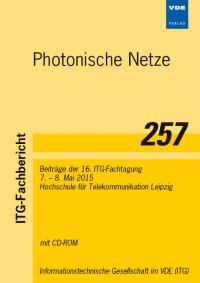Performance of CAZAC Training Sequences in Data-Aided Singlecarrier Optical Transmission Systems
Konferenz: Photonische Netze - 16. ITG-Fachtagung
07.05.2015 - 08.05.2015 in Leipzig, Deutschland
Tagungsband: Photonische Netze
Seiten: 6Sprache: EnglischTyp: PDF
Persönliche VDE-Mitglieder erhalten auf diesen Artikel 10% Rabatt
Autoren:
Noelle, Markus; Elschner, Robert; Frey, Felix; Schmidt-Langhorst, Carsten; Fischer, Johannes Karl; Schubert, Colja (Fraunhofer Institut für Nachrichtentechnik Heinrich-Hertz-Institut, Einsteinufer 37, 10587 Berlin, Germany)
Inhalt:
The ability to adaptively change the employed modulation format in order to realize transmission with flexible bit rate and spectral efficiency depending on the actual requirements of the network is a key feature for future optical networks. Data-aided channel estimation and equalization methods were shown to enable modulation format transparent digital signal processing and are therefore essential building blocks in future optical transponders. In this contribution, we investigate a popular set of training sequences, namely constant amplitude and zero autocorrelation (CAZAC) sequences, for channel estimation in nonlinear optical transmission systems. These sequences are widely used in wireless communication systems and have recently been adopted for optical systems as well. CAZAC sequences are similar to linearly chirped signals and thus can be generated with either positive or negative chirp. We show both numerically as well as experimentally that CAZAC sequences with positive and negative chirp exhibit similar performance in the case of a linear channel while their performance strongly differs in the case of nonlinear transmission. We find that the interplay of chromatic dispersion and fiber nonlinearities during transmission can cause large performance differences between two CAZAC sequences having opposite signs of the chirp. A difference in Q-factor of up to 2 dB between the two CAZAC sequences is experimentally observed for an EDFA amplified standard single-mode fiber link with 80 km spans. Hence, the sign of the frequency chirp of the CAZAC sequence has to be carefully chosen depending on the actual dispersion map of the link and the signal parameters.


